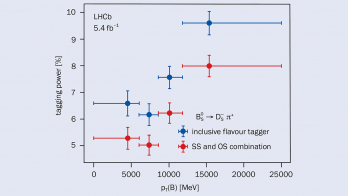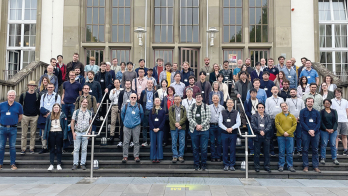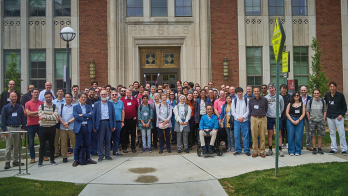As announced at the “Moriond” conference on 10 March, the LHCb collaboration has made the first observation of the decay B+ → π+μ+μ–. With a branching ratio of about 2 per 100 million decays, this is the rarest decay of a B hadron ever observed.
The LHCb experiment is designed to search for new physics in the rare decays and CP-violation of particles with heavy flavour, i.e. those containing the c or b quark. Such decays have previously been studied by the B-factory experiments BaBar and Belle, but LHCb is taking the field further as a result of two major advantages: not only are all of the varieties of heavy-flavour hadrons produced in the LHC’s high-energy collisions, but they are also produced at an enormous rate.
The B factories relied on the copious production of B+B– and B0B–0 pairs in the decay of the Υ(4S) resonance. However, in addition to those particles, collisions at the LHC also produce Bs, Bc and b baryons, which may provide an alternative route to finding new physics. This has been illustrated by recent results from LHCb on the rare decay Bs → μ+ μ–, where the strongest limit yet has been placed on the branching ratio of < 4.5 × 10–9 (at 95% CL), and the first evidence for CP-violation in the Bs system, as well as observation of new decay modes for Bc and the most precise measurements of the mass of a b-flavoured baryon.

However, the large cross-sections and luminosity at the LHC mean that even for B+ and B0 decays, LHCb can now overtake the B-factory results. The decay B+ → π+μ+μ– is a good example: it is a flavour-changing neutral-current decay, which is strongly suppressed in the Standard Model as it proceeds via quark diagrams involving loops (box or penguin diagrams). The predicted branching ratio is (2.0 ± 0.2) × 10–8 in the Standard Model but could be enhanced by new physics. The best previous limit on this mode, from the Belle experiment at KEK, was < 6.9 × 10–8 (at 90% CL) (Belle collaboration 2008). Now LHCb has observed a clear signal for the decay, shown in the figure, with a significance of more than 5 σ. The measured branching ratio of (2.4 ± 0.6 (stat.) ± 0.2 (syst.)) × 10–8 is in good agreement with the expectation from the Standard Model. This observation opens the door to more detailed studies of rare b → d transitions, which will be possible with the increase in data in 2012.
Further reading
LHCb collaboration 2012 LHCb-CONF-2012–006.
Belle collaboration 2008 Phys. Rev. D78 011101.
For other results by the LHCb collaboration mentioned here, see: arXiv:1203.4493 (Bs → μ+μ–); arXiv:1202.6251 (Bs CP-violation); CERN-PH-EP-2012–090 (Bc decay modes); LHCb-CONF-2011-060 (b-baryon mass).







